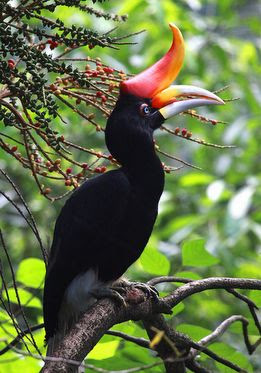Travel the world
Climb the mountains
Post Page Advertisement [Top]
BirdPets and Pets
Rhinoceros hornbill Bird Breed Reproduction,Size,Pictures and Other Information
The rhinoceros hornbill (Buceros rhinoceros) is a large species of forest hornbill. In captivity it can live for up to 35 years. It is found in lowland and montane, tropical and subtropical climates and in mountain rain forests up to 1,400 metres in Borneo, Sumatra, Java, the Malay Peninsula, Singapore, and southern Thailand.The rhinoceros hornbill is the state bird of the Malaysian state of Sarawak and the country's National Bird.Some Dayak people, especially the Ibanic groups, believe it to be the chief of worldly birds or the supreme worldly bird, and its statue is used to welcome the god of the augural birds, Sengalang Burong, to the feasts and celebrations of humankind. Contrary to some misunderstandings, the rhinoceros hornbill does not represent their war god, who is represented in this world by the brahminy kite.
Description
The rhinoceros hornbill is a large arboreal hornbill, 80 to 90 cm (31–35 in) long. The weight varies by sex, with males weighing around 2,465 to 2,960 g (87.0–104.4 oz) and the females 2,040 to 2,330 g (72–82 oz). The plumage is predominately black, with white legs and vent and a white tail with a black band. The huge bill and casque are orange and red, the colour coming from preen oil rubbed on from the preen gland above the tail. The eyes of the male are red with black rims, and white with red rims in the female.
Size
Rhinoceros hornbills are very large birds. Males are between 37.5-41.5 inches (95-105 cm) long and 5.7-7.5 pounds (2.6-3.4 kg) in weight. Females weigh 4.5-5.1 pounds (2-2.3 kg).
source https://www.dwazoo.com/animal/rhinoceros-hornbill/
Reproduction
The female nests in natural cavities 30- 49 feet (9-15 m) up in tall trees. Together the pair “wall” the female in the nest with mud; the male leaves a small hole through which he uses his long beak to pass food to the female (and hatchlings). This protects the female and eggs from predators. One or two eggs are usually incubated 37-46 days. Chicks emerge after 39-51 days and fledge in 78-80 days. The female will molt during this time period in the nest.
source https://www.dwazoo.com/animal/rhinoceros-hornbill/
Communication
The large, bony, light-weight casque amplifies the honking squawk Rhinoceros hornbills use to communicate. This loud, harsh vocalization can often be heard between pairs and often have a sharper note used for flight take- offs. Rounded wings make flight more difficult and extremely noisy (“whooshing” wing-beats sound like an overloaded locomotive).
source https://www.dwazoo.com/animal/rhinoceros-hornbill/
Diet and Feeding
The diet of the rhinoceros hornbill is dominated by fruit, but it will take any insect, small reptile, rodent, and smaller birds that it can catch.
Breeding
The courtship and bonding of these birds are critical, as the female must trust the male to provide her with everything when she is incubating and raising chicks. These hornbills make their nests inside tree trunks, and the female stays inside with the eggs and then with the chicks, while the male brings them food. After the eggs are laid, the male collects mud, and the pair pack that mud, along with food and feces, to wall up the entrance to the tree cavity. They leave a very small hole, just large enough for the male to feed the female, and later the chicks, and for the female to defecate through the hole. Once the chicks are fully feathered and old enough to leave the nest, the parents chip away the dry mud to let the chicks out.
source: Wiki
Tags: Bird
, Pets and Pets
Subscribe to:
Post Comments (Atom)



















No comments:
Post a Comment